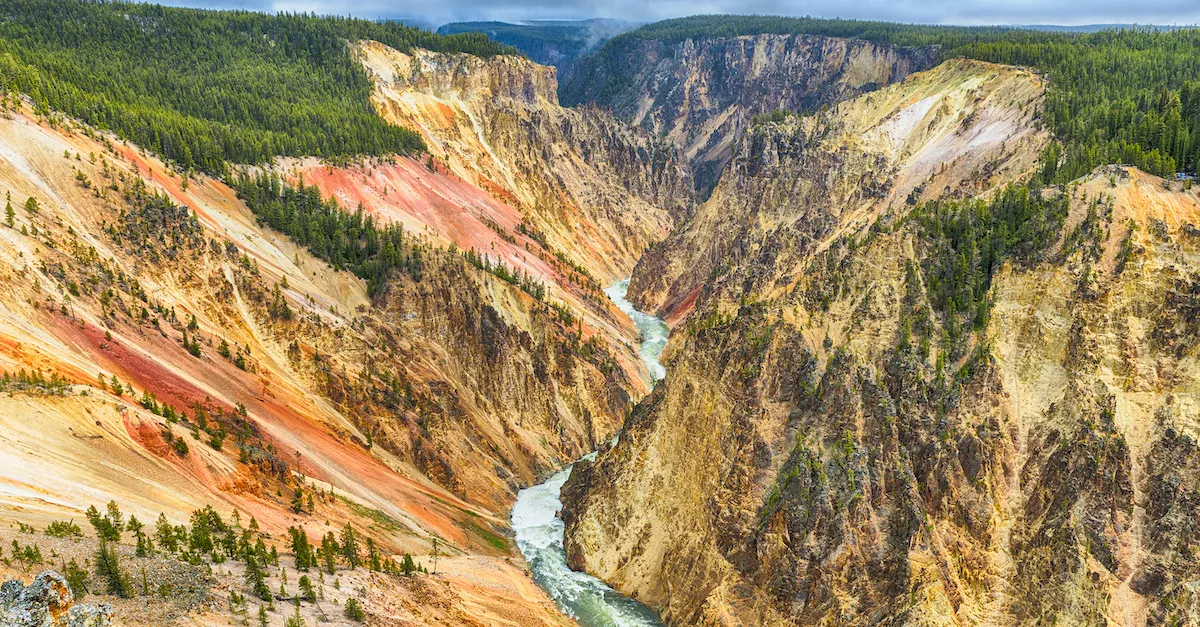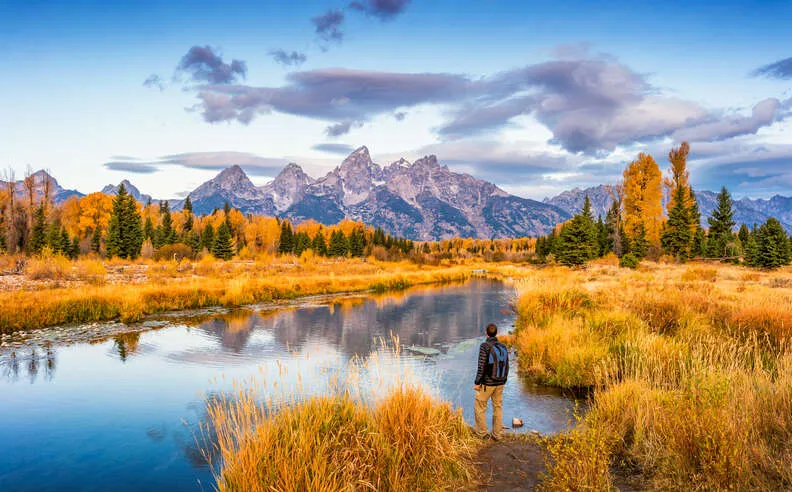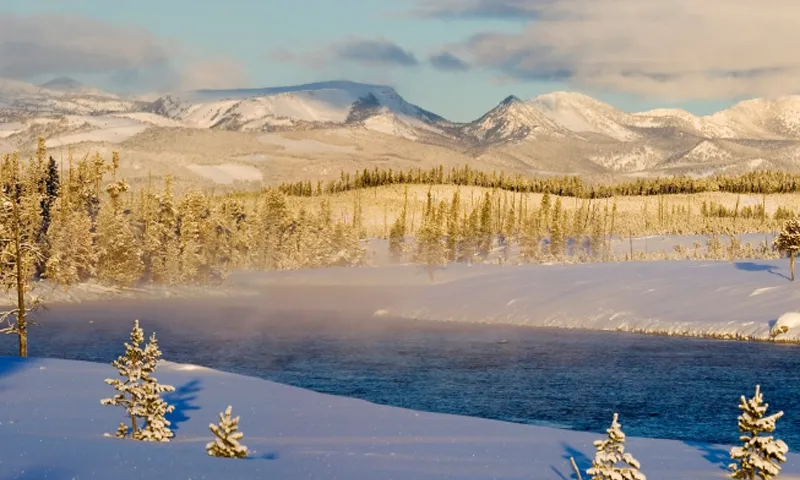Planning a trip to Yellowstone but not sure when to go? Choosing the best month to visit Yellowstone can make all the difference between a good trip and a truly unforgettable adventure. Each season in the park offers something unique, from blooming wildflowers in spring to wildlife sightings in summer, vibrant colors in fall, and peaceful, snow-covered landscapes in winter.
In this article, we’ll break down what you can expect each month in terms of weather, crowd levels, road access, and popular activities. Are you ready to explore with National Park Shops?
Spring in Yellowstone (Late April to May)
Unlike springtime in places like Texas, California, or Missouri, where you can expect blooming wildflowers and warming temperatures, Yellowstone in March, April, or Yellowstone in May offers a very different experience. These months mark the park’s most unpredictable and challenging season, often referred to as “mud season.” Far from being the best month to visit Yellowstone, spring brings thawing snow, slushy trails, and limited accessibility across much of the park.
During this off-season, melting snow transforms roads, meadows, trails, and campgrounds into a mix of mud, ice, and lingering snow, making travel difficult and hiking often unpleasant. Many of Yellowstone’s key roads remain closed, cutting off access to major sights, while most facilities, including lodges in Yellowstone, restaurants in Yellowstone, and visitor centers, have yet to open for the season. Visitors may also face frustrating conditions like sudden mudslides, icy pathways, and cold, drenching rain, which can significantly disrupt popular activities such as driving the Grand Loop, biking, or even boating.
That said, spring’s silver lining is the peace and solitude it offers. With tourism at its lowest, the park feels almost entirely your own. There’s also the special opportunity to spot newborn wildlife. Still, due to the harsh and limiting nature of this time, it’s safe to say that spring does not represent the best month to visit Yellowstone for those seeking ideal conditions and full access to the park’s wonders.

Summer in Yellowstone (June to August)
The stretch from Memorial Day to Labor Day showcases Yellowstone at its most breathtaking, with lush landscapes and ideal weather, but it also coincides with peak tourist season, drawing in millions of families on summer vacations and cross-country road trips. During these summer months in Yellowstone, over three million visitors descend on the park, making it the busiest time of year.
However, if you’re hoping to experience the park’s beauty without the heavy crowds, consider planning your trip for early June or the first half of September. This is the best time to visit Yellowstone. These shoulder periods offer a more peaceful Yellowstone, just before or after the tourist rush. In particular, early September can be the best month to visit Yellowstone, as kids are back in school, the bison rut is winding down, and mosquito activity has significantly decreased.
For those seeking a balance of stunning scenery and thinner crowds, this window might just be the second-best month to visit Yellowstone, right after whichever one works best for your travel style.

Autumn in Yellowstone (September to October)
As autumn settles over Yellowstone, the park transforms into a golden wonderland, leaves and grasses shift into stunning shades of yellow and orange, and the crisp air carries the promise of change. With the summer crowds gone, a quiet serenity returns, making fall an especially enchanting time to explore.
There are countless reasons why fall is so magical in Yellowstone National Park. Just be sure to check for seasonal road closures, which typically begin in early November, and come prepared for unpredictable weather conditions. While fall was once considered Yellowstone’s best-kept secret, its popularity has grown, so booking accommodations several months in advance is still highly recommended.
September and early October are particularly thrilling times to visit, as it’s elk rutting season – a dramatic and noisy spectacle in the wild. If you’re lucky enough to witness it, be sure to keep a safe distance. With its vibrant landscapes, active wildlife, and thinner crowds, early autumn might just be the best month to visit Yellowstone for those who love nature in its most vivid and peaceful form.

Winter in Yellowstone (November to March)
Winter in Yellowstone is nothing short of enchanting. Billowing steam from thermal vents and hot springs crystallizes into delicate frost on nearby trees, elk slowly forge paths through deep snow, and geysers erupt with scalding water that freezes into shimmering droplets midair.
This magical season typically begins in late December and can stretch well into March, offering a wonderland for adventurers. Visitors can enjoy cross-country skiing, snowshoeing, ice climbing, snowmobiling, and venturing along snow-covered trails that weave through ethereal basins like Black Sand and past frozen Yellowstone waterfalls glistening like nature’s chandeliers. For those drawn to serene landscapes and icy beauty, winter may not be the most popular, but it could just be the best month to visit Yellowstone for a truly one-of-a-kind experience.

When is the best month to visit Yellowstone National Park?
If you’re mapping out a trip to Yellowstone this year, consider timing your visit during the months below to enjoy lighter crowds, smoother traffic, and better chances for wildlife sightings and scenic exploration.
September
September offers a sweet spot for Yellowstone travelers, it still carries the lingering warmth of summer without the overwhelming crowds of peak season. With most park roads still open and wildlife activity in full swing, it’s an ideal time to explore the park’s vast landscapes at a more relaxed pace.
Whether you’re casting a line in a quiet stream, setting up camp beneath a canopy of early autumn hues, or hitting the trails for a day of hiking, backpacking, or unforgettable wildlife encounters, September delivers it all. For many nature lovers, it’s considered the best month to visit Yellowstone, blending accessibility, tranquility, and adventure into one perfect escape.
October
As the warmth of summer fades and crisp autumn air takes hold, Yellowstone undergoes a stunning transformation, offering visitors a rare glimpse of the park on the cusp of winter. October brings a quieter, more reflective atmosphere, allowing for peaceful exploration of geysers, hot springs, and thermal vents without the bustling crowds of peak season.
With plenty of room to roam and nature putting on a subtle yet powerful show, it’s easy to see why many consider October a contender for the best month to visit Yellowstone. During this time, you can still enjoy hiking, camping, backpacking, and wildlife viewing in a landscape painted with golden grasses and lingering warmth.
April
There’s something truly magical about watching Yellowstone awaken in the spring, as the snow recedes and the landscape bursts back to life. It’s also one of the most vibrant seasons for wildlife activity, bears, wolves, elk, moose, and other iconic animals begin to emerge from their winter dens, offering some of the year’s best wildlife viewing opportunities.
For those eager to explore, spring invites you to enjoy snowshoeing through the lingering drifts, set up camp as the ground thaws, and hike budding trails beneath open skies. For nature lovers hoping to witness this reawakening firsthand, spring just might be the best month to visit Yellowstone and experience the park in its most dynamic state.
When is the worst time to visit Yellowstone?
The worst time to visit Yellowstone National Park is during the peak summer months of July and August. While the weather is generally pleasant, these months attract the highest number of visitors, leading to overcrowded trails, congested roads, and long lines at popular attractions like Old Faithful and the Grand Prismatic Spring. Accommodations often require booking months in advance, and the sheer volume of tourists can diminish the overall experience.
Another challenging period is the early spring months of March through May, often referred to as the “mud season.” During this time, melting snow can lead to muddy and icy conditions, making many roads and trails difficult to navigate. Additionally, several park facilities remain closed, limiting access to certain areas and amenities.
Winter, spanning from November to March, presents its own set of difficulties. Heavy snowfall and frigid temperatures result in numerous road closures, restricting access to much of the park. While the snowy landscapes offer a unique beauty, visitors must be prepared for limited services and challenging travel conditions.

Tips for avoiding the Crowds
Even if you’re not visiting during the off-season, there are still simple and effective ways to beat the crowds and make the most of your Yellowstone adventure. With just a bit of strategic planning, you can unlock some of the park’s best experiences, no matter when you go.
One of the easiest tricks is to arrive early. Visitor traffic tends to surge in the early morning and late afternoon, so entering the park at dawn gives you a head start on the crowds and easy access to popular landmarks.
Curious about when the entrances open? The National Park Service offers a detailed list of accessible facilities to help you plan. Another great tactic is to explore Yellowstone’s hidden gems – the lesser-known geysers, hot springs, and geological features that are just as spectacular as the headline attractions but often overlooked. With hundreds of thousands of hydrothermal features scattered throughout the park, choosing the road less traveled can lead to some of the most peaceful and awe-inspiring moments.
Lastly, consider hiking to an elevated viewpoint. Many iconic landmarks are even more stunning from above. For example, the Fairy Falls Trail offers a breathtaking overhead view of the Grand Prismatic Spring, one of the park’s most colorful and photographed features.
While careful planning helps enhance any trip, visiting during the shoulder seasons can elevate your experience even further. That’s why early June or late September are often considered the best month to visit Yellowstone by those who value solitude, scenery, and full access. Pair these tips with your visit during the best month to visit Yellowstone, and you’ll be rewarded with a more relaxed, immersive, and unforgettable journey.
Conclusion
No matter when you choose to go, Yellowstone promises unforgettable scenery and adventure, but finding the best month to visit Yellowstone depends on what kind of experience you’re looking for. By planning around your interests and knowing what to expect, you’ll set yourself up for an incredible trip. So pack your bags, check the forecast, and get ready to explore one of America’s most iconic national parks at just the right time for you.
>> Read More:

